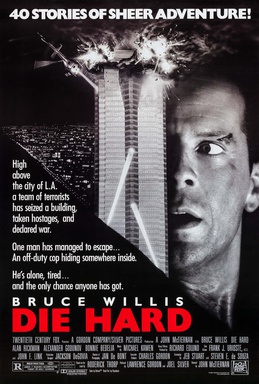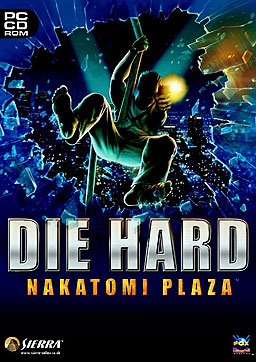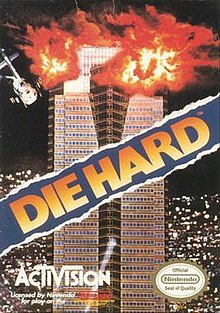
Die Hard is a 1988 American action thriller film directed by John McTiernan and written by Jeb Stuart and Steven E. de Souza based on the 1979 novel Nothing Lasts Forever by Roderick Thorp. It stars Bruce Willis, Alan Rickman, Alexander Godunov, and Bonnie Bedelia, with Reginald VelJohnson, William Atherton, Paul Gleason, and Hart Bochner in supporting roles. Die Hard follows New York City police detective John McClane (Willis) who is caught up in a terrorist takeover of a Los Angeles skyscraper while visiting his estranged wife.

Die Hard Arcade, known as Dynamite Deka in Japan, is an arcade beat 'em up video game released by Sega. It was the first beat 'em up to use texture-mapped 3D polygon graphics, and used a sophisticated move set by contemporary beat 'em up standards, often being likened to a fighting game in this respect. It also features quick time events, the ability to combine items to make more powerful weapons, and in two-player mode the ability to perform combined special moves and combos.

Die Hard: Vendetta is a 2002 first-person shooter video game developed by Bits Studios. The game was co-published by Fox Interactive, alongside Vivendi Universal Games International in Europe under their NDA Productions subsidiary, and Sierra Entertainment/Vivendi Universal Games in North America. Taking place after the first three Die Hard films, players take on terrorists as John McClane. Reginald VelJohnson reprises his role as Sgt. Al Powell. McClane's daughter, Lucy, is an L.A.P.D. member in the game.

John McClane Sr. is a fictional character and the protagonist of the Die Hard film series, based on Joe Leland from Roderick Thorp's action novel Nothing Lasts Forever. McClane was portrayed in all five films by actor Bruce Willis, and he is known for his sardonic one-liners, including the famous catchphrase in every Die Hard film: "Yippee-ki-yay, motherfucker".

Nothing Lasts Forever is a 1979 action thriller novel by American author Roderick Thorp, a sequel to his 1966 novel The Detective. The novel is mostly known through its 1988 film adaptation Die Hard, starring Bruce Willis. In 2012, the book was brought back into print and released as an ebook for the 24th anniversary of the film.

Die Hard: Nakatomi Plaza is a first-person shooter video game developed by Piranha Games and was co-published by Fox Interactive and Vivendi Universal Games through its subsidiary Sierra Entertainment exclusively for Microsoft Windows. The game originally used a modified Build engine, later the GoldSrc engine, before it was finally moved to the Lithtech engine. The game features the voice of Reginald VelJohnson, reprising his role as Al Powell.

Bloody Wolf, released in Europe as Battle Rangers, is a run and gun arcade game released by Data East in 1988. Two commandos take on an entire army with many weapons, and defeat bosses to advance levels.

Hostages is a 1988 tactical shooter video game developed and published by Infogrames for the Acorn Electron, Archimedes, Atari ST, Amiga, Apple IIGS, Amstrad CPC, BBC Micro, Commodore 64, MS-DOS, MSX, Nintendo Entertainment System, and ZX Spectrum. The game depicts a terrorist attack and hostage crisis at an embassy in Paris, with the player controlling a six-man GIGN counterterrorist team as they are deployed to defeat the terrorists and free their hostages.

The Legendary Axe is a horizontal platform video game for the TurboGrafx-16. It was developed and published by Victor Musical Industries in Japan and by NEC in North America. It was released in Japan on September 23, 1988 and in North America as a TurboGrafx-16 launch title on August 29, 1989. In the game, the player controls Gogan, a barbarian whose girl, Flare, was kidnapped by the cult of Jagu. The player must navigate through six platforming levels, armed with a legendary axe named "Sting" to defeat Jagu and his minions and rescue Flare. The game features a rechargeable "strength meter" that determines how much damage is dealt from the axe to enemies.

Somer Assault, known as Mesopotamia in Japan, is a video game developed and published by Atlus in 1991 for the TurboGrafx-16. This side-scrolling action game features an unnamed pink Slinky object/creature as the protagonist which can fire bullets from its sides, jump, and slink along walls in its quest to stop an evil sorceress. The title is a play on the word somersault, as the Slinky somersaults around the stage while assaulting enemies.

Bo Jackson Baseball is a baseball video game for the Nintendo Entertainment System, Amiga, TurboGrafx-16, and MS-DOS. It features athlete Bo Jackson, then a star in professional baseball and a former professional football player. In Europe, it was released by Mindscape as TV Sports: Baseball, part of the TV Sports series including TV Sports: Basketball and other games based on hockey and American football.

Silent Debuggers is a 1991 sci-fi horror first-person shooter video game developed and released by Data East for the PC Engine and published by NEC International for the TurboGrafx-16. The player investigates a space freight station called Gane, aided by a partner character named Leon, as they investigate why the station's crew have disappeared. The game features the "Sound Detection System" that detects, searches, and defeats enemies with sound. Silent Debuggers was notable for the TurboGrafx-16 in how it is an early entry in the first-person shooter genre.
Die Hard is an American action film series that originated with Roderick Thorp's 1979 novel Nothing Lasts Forever. All five films revolve around the main character of John McClane, a police detective who continually finds himself in the middle of a crisis where he is the only hope against disaster. The films have grossed a combined $1.4 billion worldwide.

TaleSpin is a platform game for the Sega Genesis, TurboGrafx-16, and Game Gear. It is based on the Disney animated series of the same name. Sega released the game on the Sega Mega Drive/Genesis in 1992 and Game Gear in 1993. NEC made its own game for their TurboGrafx-16 system in 1991.
There have been seven video games based on The Addams Family television series and films, released between 1989 and 2022 on various home video game consoles.

Falcon is a combat flight simulator video game and the first official entry in the Falcon series of the F-16 jet fighter's simulators by Spectrum HoloByte. Originally developed by Sphere for Macintosh and MS-DOS in 1987 and ported to several platforms between 1988 and 1992, the game earned commercial success and critical acclaim.

Jack Nicklaus' Greatest 18 Holes of Major Championship Golf is a golf-simulation video game developed by Sculptured Software, and published by Accolade beginning in 1988. It was released for the Amiga, Amstrad CPC, Apple IIGS, Atari ST, Commodore 64 (C64), MS-DOS, Macintosh, MSX, Nintendo Entertainment System (NES), PC-88, Sharp X68000, and Game Boy.

Sergeant Al Powell is a fictional character from the 1979 action thriller novel Nothing Lasts Forever and its 1988 action film adaptation Die Hard, in which he is portrayed by Reginald VelJohnson. In both the novel and the film, Powell is an off-duty police officer who gets called into work to investigate a potential hostage situation at the Klaxon Building/Nakatomi Plaza. Powell then becomes a central character in the conflict, and a source of moral support for protagonist Joe Leland/John McClane. VelJohnson would reprise his role in the sequel film Die Hard 2 (1990) and the second season of the action comedy/spy-drama television series Chuck (2008).
















